
STEALTH DRONES: NINJAS OF THE MODERN BATTLESPACE!

December 05,2011. Iran captures a United States’ (US) Lockheed Martin RQ-170 Sentinel Unmanned Aerial Vehicle (UAV) (nicknamed ‘Wraith’) over the city of Kashmar in Iran’s Northeast. The Iranian Government announced that the stealth UAV, allegedly carrying out surveillance over Iran’s’ nuclear activities, was brought down by its cyberwarfare unit which jammed the craft’s GPS uplink, commandeered and safely landed it.

US RQ-170: Source-armyrecognition.com
February 10, 2018. An Israeli Apache AH-64 Attack Helicopter shot down a Saegeh Drone near Israel’s Northern border-an alleged test flight by Iran to verify if the Israeli Air Defence could detect/intercept a ‘stealth’ drone. The drone reportedly evaded multiple attempts by Patriot Missile batteries to bring it down and the Apache helicopter was used as a last resort.
October 05, 2024. A Russian Su-57 stealth aircraft shot down a S-70 Okhotnik stealth UCAV over the city of Kostyantynivka in the Donetsk Region in Eastern Ukraine. This friendly-fire engagement was allegedly necessitated when the Su-57 possibly lost operational control over the drone in a Manned-Unmanned Teaming (MUMT) operation (read more about MUMT https://chanakyaforum.com/the-unmanned-wingman/ ), possibly due to radio-jamming by Ukraine.
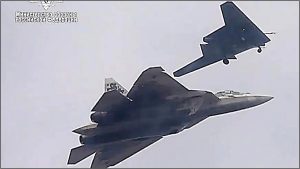
Su-57 and S-70 UCAV Flying in Tandem:Source-Russian Defence Ministry/bbc.com
October 19, 2024. Israeli Prime Minister Benjamin Netanyahu’s home in Caesarea in Central Israel (a distance of 70 Km from the Israel-Lebanon border) was targeted by one of three drones, believed to have been launched from Lebanon. The surreptitiousness of the strike over the aforementioned distance, successfully evading detection/interception, led to the inference that a stealth-drone may have been used, although collated evidence points towards probable use of an Iranian HESA Shahed-136 class of loitering munition.
October 28, 2024. A low-resolution video, likely recorded from a considerable distance with a smartphone, showing a low-observable (LO) silhouette drone, was posted on X, citing that the video was recorded the same day in Lebanon. There is speculation that the drone was the recently disclosed Israeli RA-01 stealth-drone, similar in appearance to the US Northrop Grumman RQ-180 stealth UAV, and probably flown from Israel’s Ramon Airbase. The RA-01 is probably developed from Israel Aerospace Industry’s HA-10 stealth-UAV, designed for LO intelligence-surveillance-reconnaissance (ISR) missions.
Why Are We Looking at Stealth-Drones?
Greater reliance on UAVs in the modern battlefield for ubiquitous roles, with lesser conspicuousness and risk to human life than manned aerial machines, will necessitate their persistent operation in dense Air Defence (AD) and Electronic Warfare (EW) environments, consequently increasing vulnerability. Stealth-drone designs with LO features which render detection/interception difficult and therefore allow greater survivability/penetration/time-on-station, will therefore become the need of the hour, in addition to swarm-drone technologies.
Less expensive than advanced stealth fighter aircraft, stealth-drones can perform almost all tasks that a combat aircraft can. Stealth-drones can therefore reduce the number of manned aerial platforms required for ISR/strike operations, thus reducing wartime risks and retaining combat aircraft for force critical air/counter-air and counter-surface-force operations.
Another distinct advantage is the edge offered by stealth-drones when carrying out sensitive operations viz. maintaining persistent ISR over contested airspace/an eye-in-the-sky over critical vulnerabilities outside own borders (eg:- visit of political heads) or aerial surveillance over nuclear weapon development activities of potential adversaries.
What are the Features of Stealth-Drones?
A simplistic definition of stealth-drones (a term used in this article as an umbrella moniker for UAVs/UCAVs and smaller drones) classifies them as drones designed to evade detection by electro-optical (EO) and electromagnetic (EM) sensors, during the conduct of ISR/strike missions. Design features should typically include the following:-
LO Design. Suitable visual camouflage to reduce visible-spectrum profile, full-body stealth construction with minimum external projections/non-perpendicular faceted surfaces (akin to a gemstone face and devoid of curves) to reduce radar reflectivity and diminish the Radar Cross-Section (RCS), flush fuselage, aerodynamic control surfaces and internal weapons bays (where feasible/applicable).
Radar-Absorbent Fuselage. Partial/complete coating/painting of the fuselage with Radar-Absorbent Materials (RAM) like Metal Matrix composites [1]/Advanced Polymer composites such as Graphene or Carbon Fibre Reinforced Polymers (CFRP), Neoprene [2] sheets or Salisbury screens [3] among others, to reduce detection by EM sensors. Spoofing technology- to mimic a different platform, thereby resulting in adversary’s incorrect appreciation of flight/operational plans.
Reduced Infra-Red (IR) Signature. Specially designed/positioned shielded exhaust(s) to minimise heat-signature are incorporated. The engines’ IR signature is reduced by using exhaust masking and situating the engines on top of the body/wings. Modification of the exhausts’ geometry by use of flat/wide exhausts also reduces IR signature. Use of closed-loop cooling systems and IR absorbent material to dissipate heat from the body/ engine/exhaust system. Given the relatively low speeds of stealth-drones, use of the fuel itself as a heat-sink contributes to reduced IR signature from the exhausts.
Noiseless Propulsion. Use of hybrid/electric/ducted fan engines (engines sheathed in an external duct) to reduce acoustic signature.
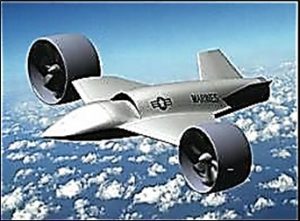
A Representative Image of a Stealth-Drone with a Ducted-Fan Engine: Source-slideserve.com
Passive EM Payloads.
Incorporation of passive sensors, where feasible, for ISR/targetting to reduce EM emissions.
Advanced Avionics.
Advanced navigation payloads to include GPS/inertial navigation, terrain-contour matching (TERCOM)/Digital Scene Mapping Area Correlation(DSMAC), Geographical Information System (GIS), Active Electronically Scanned Array (AESA) Radars, Low Probability of Intercept (LPI) Radar [4] , Synthetic Aperture Radar, Anti-Jamming/anti-spoofing equipment, Automatic Take-off and Landing System, capabilities for MUMT with manned aircraft (as elucidated in the incident above), and SATCOM. Capability to carry out Multi-Sensor Data Fusion (MSDF) and data-synthesis, and autonomous operation in a cluttered EM environment in the absence of positive commands from a Ground Control Station. Since detection of nuclear activity in target countries would invariably form part of a stealth-drone’s mandate, they might also be equipped with sensitive hyperspectral sensors capable of detecting very small amounts of radioactive isotopes/chemicals that may indicate the existence of nuclear weapons facilities.
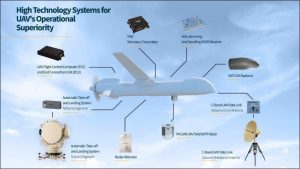
Representative Image Showing Avionics Aboard a Stealth UAV: Source- unmannedsystemstechnology.com
Global Advancements in Stealth-Drone Technology
A handful of Nations, including India have made noticeable strides in developing stealth-drone technology. Stealth-drone development has had its share of failed prototypes/technical demonstrators, likely owing to the challenges of meshing viable stealth technology with stable avionics. While the list is not exhaustive, a grab-profile of currently developmental/in-service machines representing the operational edge of stealth-drone technology, are enumerated below.
US RQ-170. The Lockheed Martin RQ-170 Sentinel (R-Reconnaissance, Q-Unmanned) is a ISR stealth-drone in service with the US Air Force since 2007. It has a single-engine, flying-wing planform (fixed, tailless wing) design, characteristic of most US stealth aerial platforms. The drone lacks extensive chiseled surfaces, shielded exhausts or zig-zag undercarriage doors, suggesting that cutting-edge stealth technology may have been intentionally avoided to obviate risk of the same falling into adversary hands. Available visuals indicate that the stealth-drone may be belly-mounted with EO/IR/hyperspectral sensor(s), AESA Radar, and overwing SATCOM. Modular payload mounts suggest that the RQ-170 could possibly be reconfigured for strike/EW/ISR missions. It is a medium-sized craft with a wingspan of 20m and a maximum take-off weight (MTOW) of ~3900 Kg. Endurance is likely to be 5-6 hours, with a service-ceiling of 50,000 feet. The stealth-drone is likely to have seen extensive service in Afghanistan, where it was first sighted in the year of its introduction into service. It is known to have been employed in tandem (likely as an unmanned wingman [UW]) with the B-2 Spirit Stealth Bomber for bomb-damage assessment. Post the capture of one bird in 2011, Iran reportedly reverse-engineered the technology and manufactured the Shahed family of drones, including the Saegeh and Simorgh, with unverified stealth characteristics.
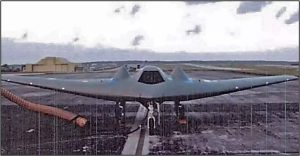
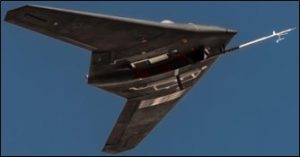
RQ-170 at Andersen Air Force Base Guam, Over Edwards Air Force Base California: SourceWikipedia/theaviationist.com

Iran’s Shahed Family of Drones: Source-english.iswnews.com
US RQ-180.
The Northrop Grumman RQ-180 White Bat is a twin-engine, High-Altitude, Long-Endurance (HALE) ISR/EW/Network Centric Warfare (NCW) enabled stealth-drone in the US arsenal, introduced into service in January 2017. The drone has a ‘cranked-kite’ layout, with the dorsal side of the wings pinched inwards. The wings are optimized for laminar flow. It also features RAM coating along its fuselage, thus enhancing LO. The craft has been designed for long-range, penetrating ISR missions into contested adversary airspace. It mounts SIGINT systems, AESA Radar and a Synthetic Aperture Radar (SAR) and is appreciated to mount a moving-target indicator, allowing live target acquisition/tracking for engagement. It is larger, stealthier, and aerodynamically superior to the RQ-170. The drone matches the RQ-4 Global Hawk in size and flight-performance, with a wingspan of approximately 40m, endurance of 24 hours, service-ceiling in excess of 60,000 feet and a combat range of over 20,000 Km. Given these performance characteristics, the platform is suited to function as a deep-penetration, high-altitude networking node for communications relay/datalink and MSDF, as well as a drone-swarm mothership. The RCS reduction stealth features of the RQ-180 are superior to those of the RQ-170 and even to those aboard the F-22 Raptor and the F-35 Lightning-II!

RQ-180 Pictured in Flight in 2021: Source-reddit.com
Note: – The double contrails are evidence of a twin-engine configuration.
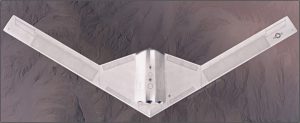
Representative Image of RQ-180: Source-twz.com
US XQ-58.
The XQ-58 Valkyrie is an experimental stealth-UCAV designed/developed by Kratos Defense & Security Solutions for the USAF’s Low Cost Attritable Strike Demonstrator (LCASD) Program. The LCASD Program commenced in 2016 to design and develop UCAVs with superior aerodynamic performance with the use of commercial industry, thus reducing manufacturing times/costs. The XQ-58 completed its maiden test flight on 05 March 2019. The operational role of the LCASD, as a fallout of the USAF’s Skyborg Program for UW development, encompasses acting as a UW to the F-22/F-35 during combat missions with strike/ISR payloads. Its LO features include a trapezoidal, chined (sharp-edged) fuselage for radar reflectivity, an internal weapons bay and S-shaped air-intake. The drone can be launched from ground/maritime/mobile platforms. It has a wingspan of 8.2 m, MTOW of 2722 Kg, 5600 Km range, 45000 feet service-ceiling and 272 Kg internal and external payload capacity. Later prototypes also mount EW payloads/underwing hardpoints for Air-to-Air Missiles. The EW version, the MQ-58B, is under development for the US Army Marine Corps and will perform the role of a UW to the F-35 for Suppression of Enemy AD (SEAD) missions.
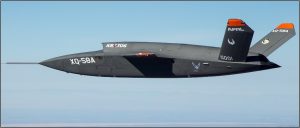
XQ-58: Source-Wikipedia

XQ-58 Flying as a UW to an F-15: Source- defenceconnect.com.au
Australia’s MQ-28.
The Boeing MQ-28 Ghostbat is a stealth, multirole drone developed by Boeing Australia for the Royal Australian Air Force. It is designed as part of the Airpower Teaming System as a UW, a component of the Loyal Wingman Advanced Development Program. It is capable of AI-powered autonomous missions. The first test-flight of the prototype took place on 27 February 2021. As of October 2024, eight prototype vehicles have been built. Though envisaged initially for ISR roles, future variants would have the option to carry weapons payloads. For quick switching of roles, the platform uses a modular mission-package system in the nose of the aircraft. The entire nose section can be removed and quickly swapped for different strike/ISR/EW mission payloads. The drone has a wingspan of 7.3 m and a range of over 3700 Km. While no RAM coating is apparent on the prototypes, the drone sports a trapezoidal, LO fuselage akin to the XQ-58. It mounts side air intakes, two cranked-kite wings and canted (tilted) V-tailplanes. The wings are made from resin-infused composite material. Underbelly configuration suggests a possible internal weapons bay.
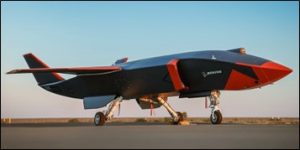

MQ-28: Source- boeing.com.au/pentapostagma.gr
Turkey’s Bayraktar Kızılelma.
The Bayraktar Kızılelma, being developed by Turkish Defence firm Baykar, is a STOL, carrier-capable, single-engine stealth-drone. The UCAV successfully completed its maiden test flight in December 2022. The present prototypes mount a Ukrainian subsonic AI-25TLT Turbofan engine. The third prototype completed its test flight on 25 September 2024. Subsequent prototypes are likely to mount a single/twin Ukrainian supersonic AI-322 Turbofan. The RAM-coated, low-RCS trapezoidal-design fuselage sports side air-intakes and a canard-delta configuration- providing greater manoeuverability but marginally compromising on LO. The AI-powered drone mounts an AESA Radar, EO tracking system, IR Search-and-Track (IRST), a missile-approach warning system and internal weapons bay. The UCAV has a wingspan of 10m, MTOW of 6000 Kg, combat radius of over 900 Km, endurance of 5 hours and operational ceiling of 35,000 feet.

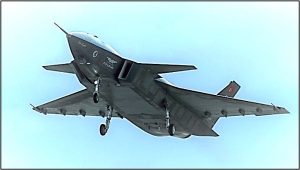
Bayraktar Kızılelma:Source-baykartech.com/aircosmosinternational.com
China’s GJ-11.
The Shenyang-Hongdu GJ-11 Sharp Sword is a single-engine, ISR/strike drone. While the maiden flight took place in November 2013, the UCAV was showcased as a UW to the Chengdu J-20 stealth fighter in October 2022. The drone is reportedly capable of autonomous take-off from Type-076 large amphibious assault ships. In addition to precision-guided munitions, the drone can mount ISR payloads or act as a swarm mother-ship. For stealth, it sports a flying-wing planform design, two internal weapons bays, covered engine-exhausts, over-fuselage air-intake and serrated weapons bay doors. The UCAV has a wingspan of 14m.
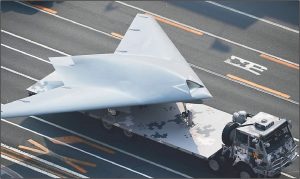
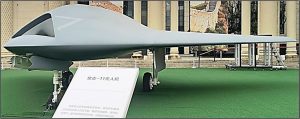
GJ-11: Source-asiatimes.com/dronejungle.org
China’s CH-7.
Developed by China Aerospace Science and Technology Corporation, the CH-7 Rainbow-7 deep-penetration, HALE UCAV is designed to undertake ISR/strike missions. First showcased at the Zuhai Airshow in 2018, and subsequently in 2022, it is strikingly similar to the US RQ-180 and sports a similar blended, cranked-kite wing design with canted wingtips. It also sports an over-fuselage air-intake, concealed engine-exhaust, internal payload bay and a central engine hump. The absence of vertical stabilizers enhances lateral stealth, since there are no flat surfaces for reflection of EM waves. The present version has a wingspan of 22m, MTOW of 10,000 Kg and endurance of 15 hours.

CH-7: Source-theaviationist.com
Russia’s S-70.
The Sukhoi/MiG S-70 Okhotnik-B is a single-engine heavy stealth-UCAV, which is thought to have entered series production this year. The drone was exhaustively flight-tested between 2019 and 2023. The UCAV encompasses technologies of the earlier MiG Skat Stealth UAV and the Su-57 Stealth Fighter and is designed as UW to the latter, in addition to autonomous roles. The UCAV was first seen in operational service during an ISR mission over Ukraine in July 2023, before the October 24 incident elucidated above. The drone sports a flying-wing design, akin to the US RQ-170 and Chinese GJ-11, and has internal weapons bays. It is coated with RAM composites and has an over-fuselage air-intake. While the existing prototypes have non-stealth engine exhaust, the later versions may sport covered exhausts. It has a wingspan of 20m, MTOW of 25,000 Kg and combat range of 3000 Km.
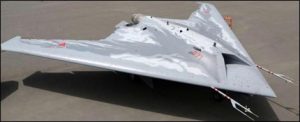
S-70: Source-msn.com
India’s Ghatak Stealth UAV
India’s Ghatak is a stealth, autonomous UCAV designed by DRDO’s Aeronautical Development Agency (ADA) and being developed from its technology demonstrator, the Stealth Wing Flying Testbed (SWiFT) by the Aeronautical Development Establishment (ADE) for the Indian Air Force (IAF). The Ghatak is based on the Autonomous Unmanned Research Aircraft (AURA) Program- a feasibility study completed in 2013. The stealth-UCAV is powered by a single turbofan engine. While maiden flight of the scaled-down model was successfully carried out in July 2022, flight-test of the full-scale prototype is expected next year. The Ghatak is expected to be powered by a dry (sans afterburners) variant of the Kaveri Turbofan engine manufactured by DRDO’s Gas Turbine Research Establishment, generating a thrust of 45-50 kN. The drone will have a wingspan of 12.5m, likely MTOW of around 13,000 Kg, range of 1500-2000 Km, endurance of 4-6 hours and a service-ceiling of 30,000 feet. It sports a flying-wing design, over-fuselage air-intake and internal weapons bay to house 1.5 tons of munitions.
The flight-test visuals also indicate an overwing-covered exhaust. The fuselage is made of carbon-composite polymers. The flight-control system and datalink payloads are being developed by ADA and DRDO’s Defence Electronics Application Laboratory. The Ghatak mounts an indigenous AESA radar and a secure data link, both developed by DRDO. The UCAV will also incorporate a fire-control radar, Identification-Friend-or-Foe and Collision-Avoidance systems. The platform would also incorporate the GPS-aided GEO Augmented Navigation (GAGAN)-an implementation of the regional Satellite-Based Augmentation System (SBAS) launched by the Government of India. Presently, weapon-integration trials and AESA radar integration have been completed, while EW suite integration is in progress. Subsequent variants would see the Ghatak as a UW. Induction into the IAF is likely to commence in 2025-26. Integration with the Indian Navy will follow a year later, with the Ghatak likely to work in tandem with the P-8I Poseidon Maritime Patrol Aircraft.
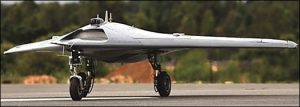
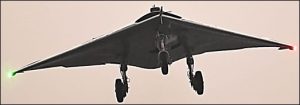
Ghatak: Source-defencedirecteducation.com/thedefensenews.com
In the saturated, contested battlespace of today and the future, superiority in operational design, especially with regard to stealth, can have immense tactical advantages and strategic ramifications. Stealth-drones showcase an increased reliance on greater unmanned participation and low-observability attributes: two cutting-edge facets of modern warfare.
[1] Iron ball paint, which contains microscopic metal-coated spheres suspended in epoxy-based paint, is one of the most frequently used RAMs. The spheres have a ferrite or carbonyl iron coating. Electromagnetic radiation is absorbed by the ferrite or carbonyl iron molecules in iron ball paint, causing them to vibrate. With the emission of heat, the molecular oscillations decrease, and this is an effective process for dampening electromagnetic waves. The oscillations generate a modest quantity of heat, which is conducted into the airframe where it dissipates (ijrti.org/papers/IJRTI2207193.pdf).
[2] Neoprene sheet containing ferrite or carbon black particles is another sort of RAM. By converting radar signals to heat, this material functions in the same way as iron ball paint (ijrti.org/papers/ IJRTI2207193.pdf).
[3] Coatings of resonant absorbers are utilized in this technology to cancel incoming signals by reflecting one from the front and the other from the opposite side of the layer. If the thickness is correct, the second reflection will have a 180-degree phase difference from the first layer reflection, cancelling the first and second waves. The method is termed as Salisbury screen(ijrti.org/papers/IJRTI2207193.pdf).
[4] A LPI Radar employs design measures to avoid detection by passive radar detection equipment (such as a radar warning receiver (RWR), or electronic support sensors, while searching for a target or engaged in target tracking.
Disclaimer
The opinions expressed in this article are the author’s own and do not reflect the views of Chanakya Forum. All information provided in this article including timeliness, completeness, accuracy, suitability or validity of information referenced therein, is the sole responsibility of the author. www.chanakyaforum.com does not assume any responsibility for the same.
Chanakya Forum is now on . Click here to join our channel (@ChanakyaForum) and stay updated with the latest headlines and articles.
Important
We work round the clock to bring you the finest articles and updates from around the world. There is a team that works tirelessly to ensure that you have a seamless reading experience. But all this costs money. Please support us so that we keep doing what we do best. Happy Reading
Support Us





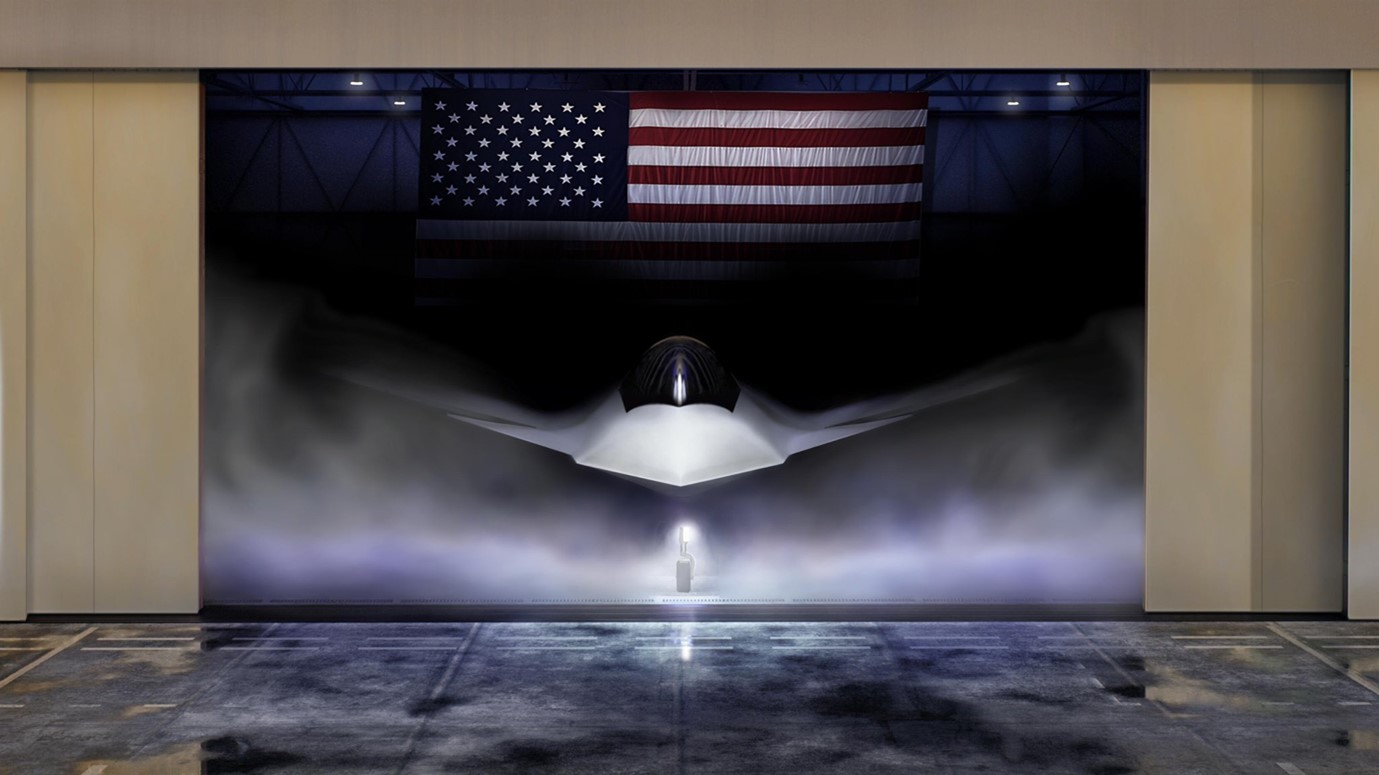









POST COMMENTS (0)